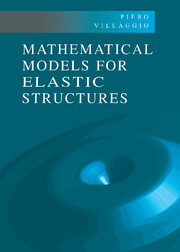Book contents
- Frontmatter
- Contents
- Preface
- Introduction
- Chapter I Basic Concepts
- Chapter II Rod Theories: Three-dimensional Approach
- Chapter III Rod Theories: Director Approach
- Chapter IV Theories of Cables
- Chapter V Theories of Membranes
- Chapter VI Theories of Plates
- Chapter VII Theories of Shells
- References
- Index of Authors Cited
- Index
Chapter V - Theories of Membranes
Published online by Cambridge University Press: 11 September 2009
- Frontmatter
- Contents
- Preface
- Introduction
- Chapter I Basic Concepts
- Chapter II Rod Theories: Three-dimensional Approach
- Chapter III Rod Theories: Director Approach
- Chapter IV Theories of Cables
- Chapter V Theories of Membranes
- Chapter VI Theories of Plates
- Chapter VII Theories of Shells
- References
- Index of Authors Cited
- Index
Summary
Constitutive Properties of Membranes
A curved membrane can be described geometrically by means of its middle surface, its contour, and its thickness. We shall take, for the moment, the thickness to be constant and equal to 2h, so that the upper and lower faces of the membrane are two surfaces each at a distance h from the middle surface and situated on opposite sides of it. We draw a closed curve s on the middle surface and consider the surface described by the normals to the middle surface drawn from the points of s and bounded by the two outer surfaces of the membrane with spacing 2h. We call this surface . The edge of the membrane is a surface like. If j1 is smooth, we can define the outer normal v at any point on s, so that v lies in the tangent plane to the middle surface, while s is the tangent to the line s, and n the normal to the middle surface, so that v, s, and n form a right-handed triad.
Let δs be a short arc of the curve s and take two generating lines of drawn through the extremities of 8s so as to include an area δA of. The tractions on the area δA are statically equivalent to a force at the centroid of δA together with a couple. The components of the forces in the v, s, and n directions are denoted by δT, δS, and δN, and those of the couple are denoted by δH, δG, and δK. So far we have introduced no specific hypothesis that distinguishes membranes from other continua having the same geometrical definition, called shells. The distinction arises from the constitutive behavior of membranes of being unable to transmit couples or forces perpendicular to the middle surface. In mathematical terms, this property is equivalent to the fact that, when δs is diminished indefinitely, the limits δH/δs, δG/δs, and δK/δs are zero, as is the limit of δN/δs. Only the limits δT/δs and δS/δs can be finite. Expressed in another way, a membrane is the two-dimensional analog of a string, that is to say, it is a two-dimensional continuum such that the only forces interacting between its parts are tangential to it.
- Type
- Chapter
- Information
- Mathematical Models for Elastic Structures , pp. 366 - 450Publisher: Cambridge University PressPrint publication year: 1997



